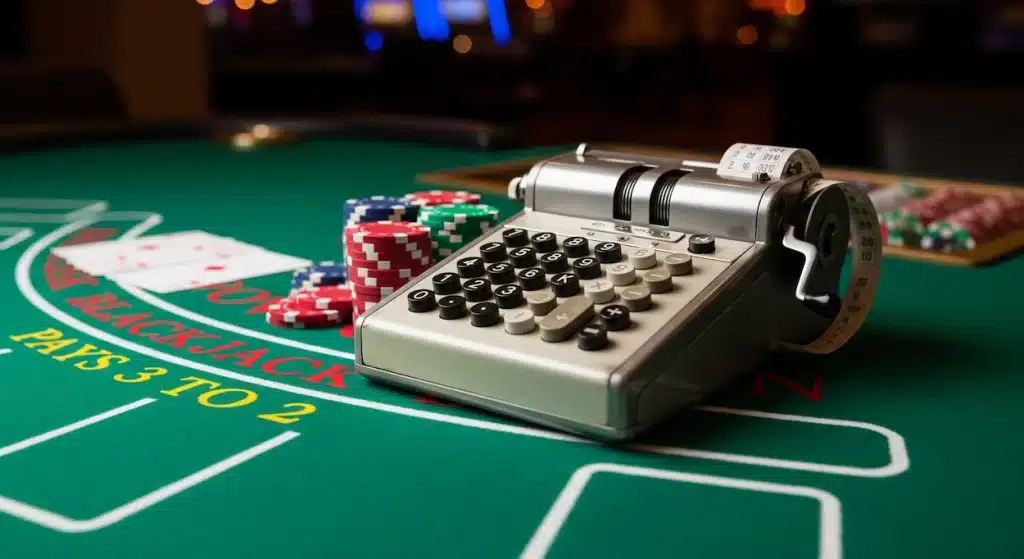If you have seen the movie ’21’ about the exploits of the MIT Blackjack Team, you may be curious as to how card counting actually works for blackjack. Well you are in the right place, as we are going to show you exactly how to introduce a card counting system into your own game.
Card counting in blackjack often conjures images of mathematical prodigies and illicit casino activities. While it does involve a degree of mental agility, the reality is far less dramatic and, for many, quite achievable. Card counting is simply a strategy used by blackjack players to determine when the odds are in their favor by keeping track of the ratio of high-value cards to low-value cards remaining in the shoe. This allows them to adjust their bets and playing strategy accordingly.
It’s important to understand that card counting is not illegal. It’s a skill-based advantage play, and while casinos dislike it and may ask you to leave if they suspect you’re doing it, you won’t be arrested.
The Basic Principle: Why It Works
The core idea behind card counting is simple:
- High cards (10s, Jacks, Queens, Kings, Aces) are generally good for the player. They increase the chances of getting a blackjack (a 10-value card and an Ace), and they are also good for doubling down. They are bad for the dealer because they increase the chance of the dealer busting when hitting on a stiff hand (12-16).
- Low cards (2s, 3s, 4s, 5s, 6s) are generally good for the dealer. They help the dealer make hands when they have to hit on a stiff total. They are bad for the player as they reduce the chances of getting a blackjack or strong totals.
When there are more high cards left in the shoe, the player’s advantage increases. When there are more low cards left, the house advantage increases. Card counting helps you identify these shifts.
The Hi-Lo System: Your Starting Point
The most popular and easiest-to-learn card counting system is the Hi-Lo system. It’s a “balanced” system, meaning that if you were to count through an entire deck of cards, your final count would be zero.
Here’s how the Hi-Lo system assigns values to cards:
- +1: 2, 3, 4, 5, 6 (Low cards – good for the player when they are out of the shoe)
- 0: 7, 8, 9 (Neutral cards – have little impact on the odds)
- -1: 10, J, Q, K, A (High cards – good for the player when they are in the shoe)
Step-by-Step Guide to Hi-Lo Counting:
1. Assign Values: Memorize the values for each card. This is crucial and must become second nature.
2. Keep a Running Count: As each card is dealt from the shoe (including the dealer’s upcard and your own cards), add or subtract its value from your current count. This is your Running Count (RC).
Example: If the cards dealt are 5, 10, 3, Ace, 8:
Start at 0.
5: 0 + 1 = 1
10: 1 – 1 = 0
3: 0 + 1 = 1
Ace: 1 – 1 = 0
8: 0 + 0 = 0
Your Running Count is 0.
3. Calculate the True Count: This is where the “art” of card counting comes in. The Running Count alone isn’t enough because it doesn’t account for the number of decks remaining in the shoe. A +5 Running Count in a single-deck game is much more significant than a +5 Running Count in an eight-deck game.To get the True Count (TC), you divide your Running Count by the estimated number of decks remaining in the shoe.True Count = Running Count / Number of Decks Remaining
Example: If your Running Count is +6 and you estimate there are 3 decks left in a 6-deck shoe, your True Count is +6 / 3 = +2.
Estimating the number of decks remaining takes practice. You’ll need to visually gauge how many cards have been played and how many decks are left.
How to Use the True Count
Once you have your True Count, you use it to make two primary adjustments:
- Bet Sizing:
- When the True Count is positive (e.g., +1 or higher), the odds are in your favor. This is when you should increase your bets. The higher the True Count, the more you should bet.
- When the True Count is zero or negative, the house has the advantage, and you should bet the minimum.
- Playing Deviations (Strategic Adjustments):
- Basic strategy is designed for a neutral deck. However, when the True Count is significantly positive, you can deviate from basic strategy to maximize your edge. For example:
- Stand on 16 vs. Dealer 10: Basic strategy says hit. But if the True Count is high (e.g., +4 or higher), you might stand, as there are fewer 10s to bust you.
- Hit on 12 vs. Dealer 3: Basic strategy says hit. But with a very low True Count, you might stand.
- These deviations are often summarized in “deviation charts” that complement basic strategy charts.
- Basic strategy is designed for a neutral deck. However, when the True Count is significantly positive, you can deviate from basic strategy to maximize your edge. For example:
Practice Makes Perfect
Card counting is a skill that requires significant practice to master. Here’s how to get started:
- Memorize Card Values: Practice assigning values to cards quickly and accurately.
- Practice Running Count: Get a deck of cards and go through it, keeping a running count. Aim to get to zero at the end of the deck. Do this repeatedly until you can do it without hesitation.
- Practice True Count: Once comfortable with the running count, practice estimating decks and calculating the true count. You can use multiple decks for this.
- Practice with a Dealer: If possible, practice with a friend acting as a dealer, dealing at a realistic pace.
- Start Small: When playing in a casino, start with small bets and focus on accuracy over speed. Don’t try to win big on your first outing.
Card counting isn’t a magic bullet for instant riches, but it’s a powerful tool that, with dedication and practice, can turn blackjack from a game of chance into a game of skill where you can gain a statistical advantage over the casino.
Card Counting Infographic
Here is an infographic which gives you a visual interpretation of the Hi-Lo system of counting cards for blackjack.
The Hi-Lo System
Unlock a statistical edge in Blackjack. It’s not magic, it’s math.
The Basic Principle: Assigning Value
Card counting works by tracking the ratio of high to low cards left in the deck. The Hi-Lo system assigns every card a simple value.
+1
Low Cards
2 3 4 5 6
These favor the player when removed.
0
Neutral Cards
7 8 9
These have a minimal impact.
-1
High Cards
10 J Q K A
These favor the player when remaining.
Deck Composition by Value
In a standard 52-card deck, the groups are balanced. A running count of a full deck will always end at 0.
The Counting Process
Your goal is to convert a simple “Running Count” into an actionable “True Count.”
1. Keep a Running Count (RC)
As cards are dealt, add their values. Example: 5(+1), 10(-1), A(-1) = RC of -1.
2. Estimate Decks Remaining
Visually gauge how many decks are left in the shoe. This takes practice.
3. Calculate the True Count (TC)
TC = RC / Decks Left
Why True Count Matters
A Running Count of +8 is powerful with 1 deck left, but weak with 6 decks left. The True Count normalizes this, revealing the true advantage.
Adjusting Your Bet
The True Count tells you when to bet big and when to bet small. This is how you gain your edge.
Path to Mastery
Card counting is a skill. Consistent practice is the only way to become effective at the table.
- Memorize Values: Drill the +1, 0, -1 values until they are instant.
- Practice Running Count: Deal a single deck, keeping count. You must end at 0.
- Practice Deck Estimation: Learn to accurately gauge the number of decks in the discard tray.
- Combine Skills: Practice keeping a running count while also converting to a true count in real-time.
- Start Small: At a casino, use minimum bets and focus on accuracy, not profit, until you are confident.







